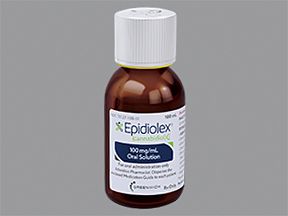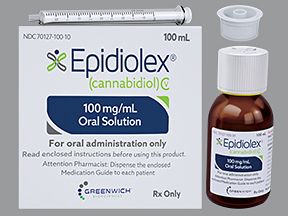Epidiolex (cannabidiol) is a brand-name drug that’s prescribed for certain types of seizures in adults and some children. Epidiolex is an oral liquid solution that you typically take twice per day. The dosage can vary depending on what condition the drug is helping to treat.
Epidiolex belongs to a drug class called cannabinoids. Epidiolex is not available in a generic version.
Keep reading for specific information about the dosage of Epidiolex, including its strength and how to take the medication. For a comprehensive look at Epidiolex, including details about its uses, see this article.
Note: This article describes typical dosages for Epidiolex provided by the drug’s manufacturer. When taking Epidiolex, always follow the dosage prescribed by your doctor.
The information below describes the typical dosage of Epidiolex and other details about the drug.
Epidiolex form
Epidiolex comes as a strawberry-flavored oral liquid solution.
For details on how it’s taken, see the “How to take Epidiolex” section below.
Epidiolex strength
Epidiolex comes in one strength: 100 milligrams (mg) per milliliter (100 mg/mL).
Typical dosages
Typically, your doctor will prescribe a low dosage at the start of treatment. Then they’ll adjust it over time to reach the amount that’s right for you. Your doctor will ultimately prescribe the smallest dosage that provides the desired effect.
Epidiolex dosages are based on body weight in kilograms (kg).* Your doctor will use a dosing calculator to determine your dosage.
The following information describes dosages that are commonly prescribed or recommended. However, be sure to take the dosage your doctor prescribes for you. They’ll determine the best dosage to fit your needs.
* For reference, 1 kg is about 2.2 pounds (lb).
Dosage for seizures due to Lennox-Gastaut Syndrome or Dravet syndrome
Epidiolex is used to treat seizures due to Lennox-Gastaut syndrome* or Dravet syndrome in adults and some children. The typical starting dosage is 2.5 mg/kg of body weight twice per day.
After about 1 week, your doctor may increase your dosage to 5 mg/kg of body weight twice per day. This is the typical maintenance dosage. Your doctor may increase your dosage further to reach the desired effect. Dosage increases may occur over several days or weeks of treatment. The maximum dosage is 10 mg/kg of body weight twice per day.
* Lennox-Gastaut syndrome is a severe form of epilepsy that causes frequent seizures.
Dosage for seizures due to tuberous sclerosis complex
Epidiolex is used to treat seizures due to tuberous sclerosis complex in adults and some children. The typical starting dosage is 2.5 mg/kg of body weight twice per day.
The typical maintenance dosage for Epidiolex is 12.5 mg/kg of body weight twice per day. To reach your maintenance dosage, your doctor will slowly increase your dosage over several weeks. The specific timing of dosage increases likely depends on how your body responds to the drug.
Children’s dosage
Epidiolex is approved to treat certain seizures in children ages 1 year and older. The dosage for children is the same as the adult dosage. You can refer to “Typical dosages” above for more details.
Long-term treatment
Epidiolex is meant to be taken as a long-term treatment. If you and your doctor determine that Epidiolex is safe and effective for you, you’ll likely take it long term.
Talk with your doctor if you have questions about your or your child’s Epidiolex dosage or treatment plan.
The Epidiolex dosage your doctor prescribes will depend on several factors. These include:
- the type and severity of the seizures you’re taking Epidiolex to treat
- your body weight, which may change over time
- how well your liver is working
- other medications you may be taking
Other medical conditions you have can also affect your Epidiolex dosage.
Dosage adjustments
If you have certain liver problems, your doctor may prescribe a lower dosage of Epidiolex. So if you’ve ever had a liver condition, tell your doctor. They’ll also likely check your liver function before you start taking Epidiolex and regularly during treatment.
Epidiolex comes as a strawberry-flavored liquid solution that you’ll swallow. It’s supplied in a bottle with oral syringes that have a soft tip. Your doctor or another healthcare professional will show you how to take Epidiolex. You’ll typically follow these steps:
- Use one of the supplied syringes to measure your prescribed dose. You may need to use a 1-milliliter (mL) syringe or a 5-mL syringe, depending on your dose.
- Place the tip of the syringe in your mouth against the inside of your cheek.
- Gently press the plunger and swallow the medication.
- Clean the syringe and plunger with warm, soapy water.
- Rinse the syringe and plunger and allow to air dry.
If your child’s doctor prescribes Epidiolex, they’ll show you how to give your child their dose.
For details about how to take Epidiolex, you can refer to the manufacturer’s step-by-step guide. You can also call the manufacturer’s helpline at 833-426-4243.
Talk with your doctor or pharmacist if you have questions about how to take Epidiolex.
ACCESSIBLE DRUG LABELS AND CONTAINERSSome pharmacies offer labels with large print, braille, or a code you scan with a smartphone to convert text to speech. If your local pharmacy doesn’t have these options, your doctor or pharmacist might be able to recommend a pharmacy that does.
If you’re having trouble opening medication bottles, ask your pharmacist about putting Epidiolex in an easy-open container. They also may recommend tools that can make it easier to open bottles.
If you miss a dose of Epidiolex, take it as soon as you remember. If it’s almost time for your next dose, skip this missed dose and take your scheduled dose. Do not take two doses at once to make up for the missed one.
To help make sure that you don’t miss a dose, try using a medication reminder. This can include setting an alarm or putting a note where you’ll see it, such as on your bathroom mirror or bedside table. You could also download a reminder app on your phone.
If you have questions about whether to take or skip a missed dose, talk with your doctor or pharmacist.
It’s important that you do not take more Epidiolex than your doctor prescribes. For some medications, taking more than the recommended amount may lead to side effects or overdose.
If you take more than the recommended amount of Epidiolex
Call your doctor right away if you believe you’ve taken too much Epidiolex. Another option is to call America’s Poison Centers at 800-222-1222 or use its online tool. If you have severe symptoms, immediately call 911 or your local emergency number, or go to the nearest emergency room.
Dependence* and withdrawal* aren’t likely to occur with Epidiolex. People taking the drug in clinical trials didn’t experience withdrawal symptoms when the trial ended.
However, if you were to stop taking Epidiolex suddenly, you may:
- have more seizures
- increase your risk of status epilepticus (a seizure that lasts longer than 5 minutes)
If your doctor recommends that you stop taking Epidiolex, they’ll likely decrease your dosage slowly over time. This is to help avoid the side effects above.
Talk with your doctor if you have questions about dependence and withdrawal with Epidiolex.
* With dependence, your body needs the drug to function as it typically does. Withdrawal symptoms are side effects that can occur when you stop taking a drug that your body has become dependent on.
The dosages in this article are typical dosages provided by the drug manufacturer. If your doctor recommends Epidiolex for you, they’ll prescribe the dosage that’s right for you. Always follow the dosage that your doctor prescribes.
As with any drug, never change your dosage of Epidiolex without your doctor’s recommendation. If you have questions about the dosage of Epidiolex that’s best for you, talk with your doctor.
Besides learning about dosage, you may want other information about Epidiolex. These additional articles might be helpful:
- More about Epidiolex. For information about other aspects of Epidiolex, refer to this article.
- Cost. To learn about cost and Epidiolex, you can read this article.
- Details about your condition. For details about epilepsy and seizures, see our epilepsy and seizures hub.
Disclaimer: Medical News Today has made every effort to make certain that all information is factually correct, comprehensive, and up to date. However, this article should not be used as a substitute for the knowledge and expertise of a licensed healthcare professional. You should always consult your doctor or another healthcare professional before taking any medication. The drug information contained herein is subject to change and is not intended to cover all possible uses, directions, precautions, warnings, drug interactions, allergic reactions, or adverse effects. The absence of warnings or other information for a given drug does not indicate that the drug or drug combination is safe, effective, or appropriate for all patients or all specific uses.


